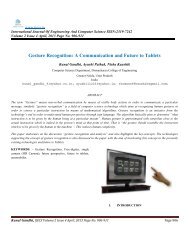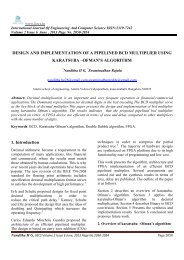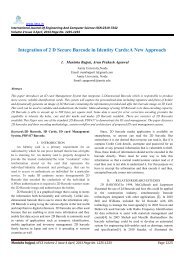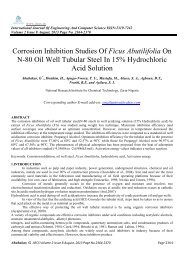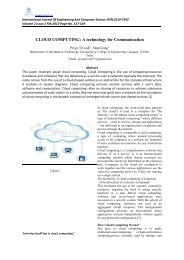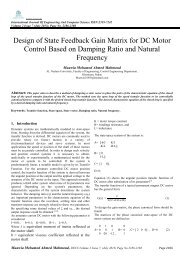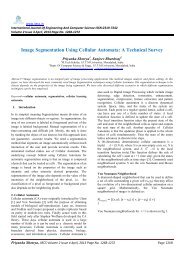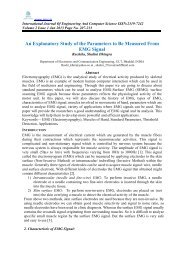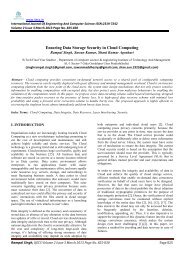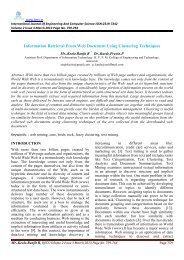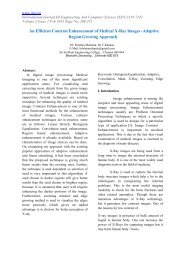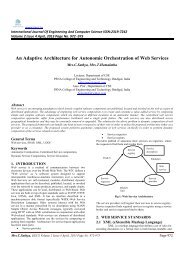elements with either straight sides or curved sides are very widely used in a variety of applications [1-3]. The basic problem of integrating a function of two variables over the surface of the triangle is the subject of extensive research by many authors [4-5]. Derivation of high precision formulas is now possible over the triangular region by application of product formulas based only on the sampling points and weights of the well known Gauss Legendre quadrature rules [6-8]. There are reasons which support the development of composite integration for practical applications. In some recent investigations composite integration is illustrated with reference to the standard triangle [9-10]. Recently, in [11] Green’s integral formula is used in the numerical evaluation of II ( f ) f ( x, y) dxdy by transforming a two dimensional problem into a one dimensional problem and by <strong>using</strong> univariate Gauss Legendre quadrature products. In [12], a cubature formula over polygons is proposed which is based on a 8-node spline finite elements. They use very dense meshes to prove the convergence of test function integrals for which error is shown to be in the range of 10 -1 to 10 -9 . In this paper we develop composite integration rules for polygonal domains which are fully discretised by special quadrilaterals and the test function integrals are shown to agree with the exact values up to 16 significant digits for smooth functions, this implies that the absolute error is of the order 10 -16 . The composite integration rules of this paper as well as the cubature formulas of 8- node spline elements [12] converge to the exact values a little slowly for some nonsmooth functions. This again confirms the superiority of product formulas. In section 2 of this paper, we begin with a brief description of the special discretisation of arbitrary and the standard (right isosceles) triangular elements into a set of three special quadrilaterals which are obtained by joining the centroids to the midpoints of sides. In section 3 of this paper, we define some relevant linear transformations. In section 3.1, we prove lemma 1, which establishes the relation between the special quadrilaterals of an arbitrary triangle in ( x, y) space and the special quadrilaterals of the standard triangle in ( u , v) space by use of a single linear transformation between the global space ( x , y) and the local parametric space ( u , v) . Then in section 3.2, we prove lemma 2 which establishes the relation between the three special quadrilaterals in ( x, y) and a unique special quadrilateral interior to the standard triangle in ( u , v) space by <strong>using</strong> three linear transformations. Section 4 of this paper is regarding the explicit form of the Jacobians. In section 4.1, we determine the explicit form of Jacobian when the arbitrary triangle in the global space ( x, y) is mapped into a standard triangle in the local space ( u , v) for the linear transformations used in lemma 1 and lemma 2. Section 4.2 of the paper begins with the derivation of explicit form of Jacobian for an arbitrary linear convex quadrilateral. In section 4.3, we determine the Jacobian for the special quadrilaterals Q e ( e 1,2,3) in the global space ( x, y) and the Qˆ e ( e 1,2,3) in the local space ( u , v) , in either case we obtain the Jacobian as c ( 4 ) , where c is some appropriate constant. We prove this result in lemma 3 when the Qˆ e ( e 1,2,3) are mapped into 2- squares 1 , 1. In section 5, we establish two composite integration formulas which use lemmas 1, 2 and 3 proved in sections 3.1, 3.2 and 4.3. In section 5.1, we establish a composite integration formula which uses three bilinear transformations and a single linear transformation and in section 5.2, we also establish a composite integration formula which depends on three linear transformations and a single linear transformation. We see that composite integration formulas of section 5.1 are of the form e e e e x ( u ( , ), v ( , )), y( u ( , ), v ( , )), e 1, 2, 3 and require the computation of three sets ( u e , v e ), 1 1 e 1, 2,3 whereas the composite formulas of section 5.2 are of the form x e ( u ( , ), v ( , )), 1 1 y e 1 1 ( u ( , ), v ( , )), and require the computation of one set ( u ( , ), v ( , )) . Thus we prefer to use composite integration formula of section 5.2. In section 6, we present the composite numerical integration formulas. We may note that the problem domain must be discretised into special quadrilaterals. The problem domain must contain at least one triangle for this purpose. The composite integration formulas are then obtained by application of Gauss Legendre quadrature rules [4] to the formula established in section 5.2. In section 7, we derive boundary integration methods to compute the integrals over a polygonal domain. They are helpful in verifying the application of proposed composite integration formulas. In section 8, we consider the evaluation of some typical integrals. This demonstrates the efficiency of the derived formulas of last section. We have also appended the relevant and necessary computer codes. 2 A Special Discretization of Triangles H. T. Rathod a IJECS Volume 2 Issue 8 August, 2013 Page No.2576-2610 Page 2575
In this section, we describe a special discretisation scheme to generate quadrilaterals from triangles. In the proposed scheme, three unique quadrilaterals are obtained by joining the centroid of any triangle to the midpoints of its sides. We define such quadrilaterals as special quadrilaterals for our present investigations. 2.1 Special Quadrilaterals of an Arbitrary Triangle We first consider an arbitrary triangle PQR in the Cartesian space ( x, y) with vertices P x p , y ), Q x q , y ) ( p ( q and R ( x r , yr ) . Let Z(( x p xq xr ) / 3, ( y p yq yr ) / 3)) be its centroid and also let S, T, U be the mid points of sides PQ, QR and RP respectively. Now by joining the centroid Z to the midpoints S, T, U by straight lines, we divide the triangle PQR into three special quadrilaterals Q 1 , Q 2 and Q 3 (say) which are spanned by vertices Z , U, P, S , Z , S, Q, T , and Z , T, R, U respectively.This is shown in Fig.1a 2.2 Special Quadrilaterals of a Standard Triangle We next consider the triangle ABC in the Cartesian space ( u, v) with vertices, centroid and midpoints: A( 1,0), B(0,1), C(0,0), G(1 3,1 3), D(1 2,1 2), E(0,1 2) and F(1 2,0). We now divide the triangle ABC into three special quadrilaterals Qˆ , ˆ 1 Q 2 , and ˆQ 3(say) which are spanned by vertices G , E, C, F , G , F, A, D , and G , D, B, E respectively. This is shown in Fig.1b 3 Linear Transformations We apply linear transformations to map an arbitrary triangle into a triangle of our choice. In this section, we use the well known linear transformation which maps an arbitrary triangle into a standard triangle (a right isosceles triangle). We also assume the special discretization scheme of the previous section for the following developments. 3.1 Lemma 1. There exists a unique linear transformation which map the special quadrilaterals Qi into Qˆ i (i =1, 2, 3) satisfying the conditions 3 (i) Q i PQR , the arbitrary triangle in the ( x, y) space. i1 3 (ii) Q ˆ i ABC , the standard triangle (right isosceles) in the ( u, v) space. i1 Fig.1a and Fig.1b H. T. Rathod a IJECS Volume 2 Issue 8 August, 2013 Page No.2576-2610 Page 2576



